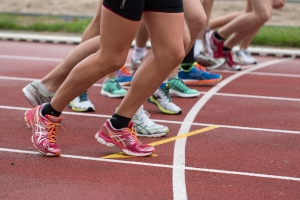 Most people know that chiropractic care can help with back pain, immune function, and overall health and wellness, but did you also know that chiropractic care can help improve athletic performance? Whether you’re just starting an exercise regime, you’re a well-established gym junkie, or you are an aspiring professional athlete, you want to stay healthy and injury-free and you want to improve your performance, and chiropractic can help!
Most people know that chiropractic care can help with back pain, immune function, and overall health and wellness, but did you also know that chiropractic care can help improve athletic performance? Whether you’re just starting an exercise regime, you’re a well-established gym junkie, or you are an aspiring professional athlete, you want to stay healthy and injury-free and you want to improve your performance, and chiropractic can help!
Lithia Springs chiropractor Dr. Ronnie Bolar has seen first-hand the effects of chiropractic on athletic performance. As the world is turning more and more to non-traditional healthcare, chiropractic is among the most talked-about ways to heal from injuries, improve wellness, and prevent sickness, and for good reason.
Chiropractic Care in the NFL
It is estimated that 90% of the world’s top-tier athletes use chiropractic care on a regular basis. As of 2015, every single NFL team has a chiropractor work with their team in some capacity, and 77% of NFL trainers have referred players to a chiropractor for some form of treatment or evaluation. Many well-known NFL players have spoken about the benefits of chiropractic and how vital chiropractic care is to their success. Some of these NFL players include Aaron Rodgers, Tom Brady, Reggie Bush, Jerry Rice, Michael Strahan, and Marques Colston.
Chiropractic Is Beneficial for All Athletes at All Levels
Even if you’re not an aspiring professional athlete or a football player who experiences a lot of hard hits, chiropractic care is still incredibly beneficial for helping you heal from a sports-related injury or improving your overall athletic performance. Those receiving chiropractic care experience shorter recovery time from injuries and hard workouts, increase performance when it comes to speed, agility, and reaction time, and have improved balance and power in their workouts or sports performances.
A study published in 1991 tested fifty athletes, separating them into a control group and a group that received chiropractic care. After six weeks, the control group was tested with the same 11 tests they utilized at the start of the study, and they exhibited minor improvements in 8 of the 11 tests. The chiropractic group showed significant improvement in all 11 tests, and also showed an 18% improvement in a reaction test, compared to the control group’s less than 1% improvement.
Why Does It Work?
Chiropractors adjust the spine to ensure proper alignment and to reduce nerve interference between the brain and the rest of the body. Chiropractic care focuses on proper and optimal body function, so it helps to make everything work the way it should, including allowing the body to self-heal from an injury or hard workout. Additionally, with proper blood flow and nerve function throughout the entire body, an individual has an easier time improving his or her athletic performance, including speed, agility, balance, strength, and more.
At Vital Life Chiropractic in Lithia Springs, Dr. Ronnie is passionate about helping all athletes at all levels of performance improve their abilities and be all-around healthier. Contact the amazing staff at Vital Life Chiropractic today to set up your consultation.
Sources
Grimston, S.K., Engsberg, J.R., Shaw, L., Vetanze, N.W. “Muscular Rehabilitation Prescribed in Coordination with Prior Chiropractic Therapy as a Treatment for Sacroiliac Subluxation in Female Distance Runners.” Chiropractic Sports Medicine, 1990 Jan; 4: 2-8. https://www.researchgate.net/publication/285677024_Muscular_rehabilitation_prescribed_in_coordination_with_prior_chiropractic_therapy_as_a_treatment_for_sacroiliac_subluxation_in_female_distance_runners.
Lauro, A., Mouch, B. “Chiropractic Effects of Athletic Ability.” Chiropractic: The Journal of Chiropractic Research and Clinical Investigation. 1991; 6: 84-87. http://icpa4kids.org/Chiropractic-Research/chiropractic-effects-on-athletic-ability.html.
Stump, J.L., Redwood, D. “The Use and Role of Sport Chiropractors in the National Football League: A Short Report.” Journal of Manipulative and Physiological Therapeutics, 2002 Mar-Apr; 25(3): E2. https://www.ncbi.nlm.nih.gov/pubmed/11986584.
